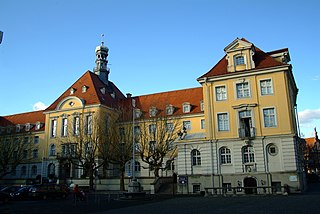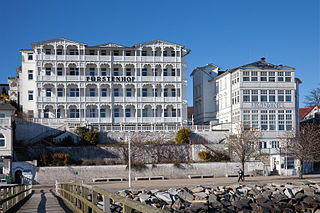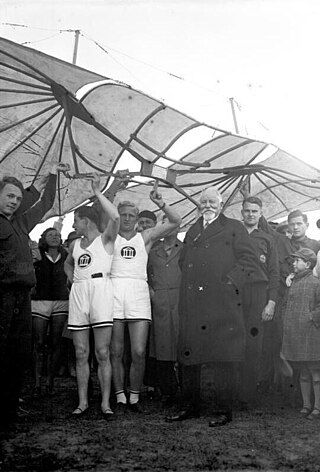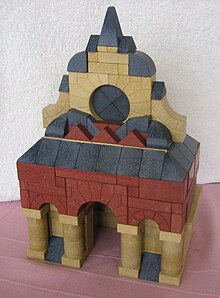
Flint, occasionally flintstone, is a sedimentary cryptocrystalline form of the mineral quartz, categorized as the variety of chert that occurs in chalk or marly limestone. Flint was widely used historically to make stone tools and start fires.

Chalk is a soft, white, porous, sedimentary carbonate rock. It is a form of limestone composed of the mineral calcite and originally formed deep under the sea by the compression of microscopic plankton that had settled to the sea floor. Chalk is common throughout Western Europe, where deposits underlie parts of France, and steep cliffs are often seen where they meet the sea in places such as the Dover cliffs on the Kent coast of the English Channel.

Herford is a town in North Rhine-Westphalia, Germany, located in the lowlands between the hill chains of the Wiehen Hills and the Teutoburg Forest. It is the capital of the district of Herford.
Putty is a material with high plasticity, similar in texture to clay or dough, typically used in domestic construction and repair as a sealant or filler. Although some types of putty slowly polymerise and become stiff, many putties can be reworked indefinitely, in contrast to other types of filler which typically set solid relatively rapidly.

Linoleum is a floor covering made from materials such as solidified linseed oil (linoxyn), pine resin, ground cork dust, sawdust, and mineral fillers such as calcium carbonate, most commonly on a burlap or canvas backing. Pigments are often added to the materials to create the desired colour finish. Commercially, the material has been largely replaced by sheet vinyl flooring, although in the UK this is often still referred to as lino.

Friedrich Wilhelm August Fröbel or Froebel was a German pedagogue, a student of Johann Heinrich Pestalozzi, who laid the foundation for modern education based on the recognition that children have unique needs and capabilities. He created the concept of the kindergarten and coined the word, which soon entered the English language as well. He also developed the educational toys known as Froebel gifts.

The Froebel gifts are educational play materials for young children, originally designed by Friedrich Fröbel for the first kindergarten at Bad Blankenburg. Playing with Froebel gifts, singing, dancing, and growing plants were each important aspects of this child-centered approach to education. The series was later extended from the original six to at least ten sets of gifts.

Autoclaved aerated concrete (AAC) is a lightweight, precast, cellular concrete building material, eco-friendly, suitable for producing concrete-like blocks. It is composed of quartz sand, calcined gypsum, lime, portland cement, water and aluminium powder. AAC products are cured under heat and pressure in an autoclave. Developed in the mid-1920s, AAC simultaneously provides structure, insulation, and fire- and mold-resistance. Forms include blocks, wall panels, floor and roof panels, cladding (façade) panels and lintels. AAC is a highly durable material that can last for many years without requiring maintenance. It is also an excellent insulator that can help reduce energy costs by keeping buildings cool in the summer and warm in the winter. Additionally, AAC is resistant to fire and mold, making it a safe choice for construction.

Sassnitz is a town on the Jasmund peninsula, Rügen Island, in the state of Mecklenburg-Vorpommern, Germany. The population as of 2012 was 9,498.

Rudolstadt is a town in the German federal state Thuringia, within the Thuringian Forest, to the southwest, and to Jena and Weimar to the north.

Bodenheim is a state-recognized tourism municipality (Fremdenverkehrsgemeinde) in the Mainz-Bingen district in Rhineland-Palatinate, Germany

F. Ad. Richter & Cie was founded and owned by Friedrich Adolf Richter. This German manufacturer produced many products, including pharmaceuticals, music boxes, gramophones, and Anchor Stone building sets. He established his main factory in Rudolstadt, Germany. In addition, the company had factories in Vienna Austria, Nuremberg Germany, New York City USA, and St. Petersburg, Russia. In addition, the company had operations for internal supply in Konstein, Germany and Leipzig, Germany.

Artificial stone is a name for various synthetic stone products produced from the 18th century onward. Uses include statuary, architectural details, fencing and rails, building construction, civil engineering work, and industrial applications such as grindstones.

Chemtou or Chimtou was an ancient Roman-Berber town in northwestern Tunisia, located 20 km from the city of Jendouba near the Algerian frontier. It was known as Simitthu in antiquity.

The Royal Porcelain Factory in Berlin, also known as the Royal Porcelain Manufactory Berlin and whose products are generally called Berlin porcelain, was founded in 1763 by King Frederick II of Prussia. Its actual origins, however, lie in three private enterprises which, under crown patronage, were trying to establish the production of "white gold" in Berlin from the mid-18th century onwards.

Gustav Lilienthal was a German social reformer, a pioneer in building and construction technology, inventor of different Construction sets and involved in the pioneering work of his brother, Otto Lilienthal in aviation.
Events in the year 1893 in Germany.

Volkstedt porcelain manufactory sited in Rudolstadt, Thuringia, Germany, was the earliest porcelain manufactory in Thuringia. It was in business as Aelteste Volkstedter Porzellanmanufaktur, the "Oldest Volkstedt Porcelain Manufactory", which was integrated into the VEB Vereinigte Zierporzellanwerke Lichte, which in turn formed part of the Kombinat Feinkeramik Kahla.
Weimar Porzellanmanufaktur, or Weimar Porzellan is a German company that has been manufacturing porcelain in Weimar since 1790.

Martin Gottlieb Klauer was a German sculptor, and one of the first teachers at the Weimar Princely Free Drawing School.



















